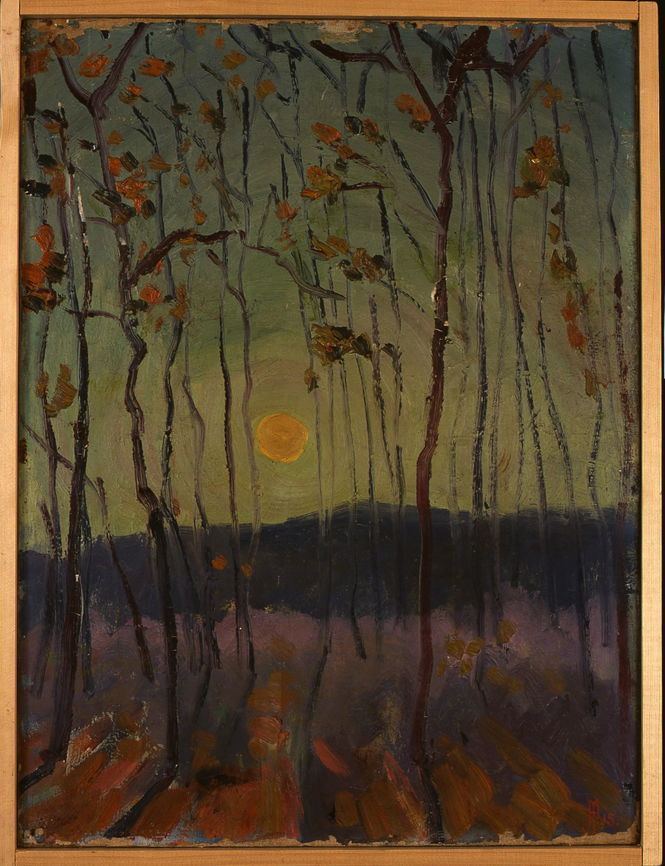Name Jan Herwijnen | ||
 | ||
Jan van herwijnen the insanity drawings movie
Johannes Adrianus George van Herwijnen (4 November 1889 in Delft – 12 April 1965 in Bergen) was a Dutch painter.
Contents
- Jan van herwijnen the insanity drawings movie
- Jan van herwijnen vertelt over zijn leven werk vrouw de krankzinnigentekeningen
- References
[f.e. THE INSANITY DRAWINGS]
"To really see art you first must detach from it, that's what it all about. A painting is like music, you should not view, you should listen."
Van Herwijnen was born in Delft and grew up in the Jordaan (Amsterdam). He was different from the rest of the family. At nine he went to the Rijksmuseum a tile table for copying, his master had given him a box of paints. Concerts and museums hold him up as he began his eleventh year to earn a living. When he was 21 he was clear: "Suddenly I knew I could see ". Then I gained consciousness only. Before that time I had looked into the world through the eyes of a child. But then I knew who I was and what to do. I started in the Rijksmuseum, because I knew the road. Every day I sat there and it was like I had always painted. "
He wants no classes, no academy. He represents himself by copying the old masters. In 1912 he goes to Paris without a penny. Half starved he comes back. He begins to draw people. Poor models of the street and blind and deaf. With the insanity life-size drawings from 1919 he established his name. He works hard on these drawings and identifies himself with his models, he is exhausted. The craziness with which he has handled this matter radiates from each drawing: heavy black lines and contours of a figure on a chair in an empty room. Van Herwijnen is now supported by many prominent figures, among which Prof. RN Roland Holst.
He went to France with his family and lived from 1921 to 1923 in Collioure. The paintings of Collioure feature the clean lines of the drawings in which the paint is filled with lots of blue and purple. Then follows a gloomy period when his wife leaves him. Paintings reflect his depressive state and are very dark. When he goes to Florence, his work is lightened. "The conquest of light" in all newspapers and magazines celebrated with superlatives. "Van Herwijnen in the front ranks of contemporary painters came." In the autumn of 1934, he moved a house in the new studio complex on the Summer Dijkstraat. Van Herwijnen married again and moved to Bergen in 1945. His work is still cheering "A picture of joy - great development of a strong talent - refined spirituality - colored music - this country equaled by no other." Van Herwijnen is suspicious. His work is than heavier, sometimes lighter. A pattern of doubt in his entire oeuvre can be seen. In its lightest years he painted many flowers.
He sometimes tries to explain: "I paint the light. Not the physical light, a light that casts shadows. I paint the light in the shade. "
The special treatment of his paint and his brush was repeatedly emphasized. One critic in 1937 writes: "Perhaps our most gifted painter of today, is usually attracted to very simple matters. Twenty years later, another note: "There is never a dead spot, every square inch of a living painting, as if the light is gently shaking."
Lunatics In 1919 the artist signed a series of life-size portraits of the insane from the Utrecht William Arntz Foundation. In his own life he would himself have to deal with mental breakdowns. Sometimes he went to the utmost of his ability. Shortly after World War II Van Herwijnen painted a series of portraits of dead.
Colorful and light - powerful and sombre The born in Delft Van Herwijnen grew up as child in Amsterdam. He was a self-taught and developed in its own direction, without having to join an art group. He is sometimes conveniently classified in a group of artists (the Bergen School), but that's not right.
The delusion, the insane The series is loosely inspired by the iconographic series "The insane '. After a psychological crisis, the self-taught artist Jan van Herwijnen (1889–1965) had created drawings of psychiatric patients in the William Arntz Foundation in Utrecht. He quickly gets the interest from treating physicians and teachers of the medical faculty. The 'insanity drawings' in 1920 are exhibited. Since 2005 the Museum of Modern Art Arnhem received a long term loan of this impressive series of drawings made with black chalk at life-size format.
Seven The number seven, the seven paintings bear the idea of perfection in themselves as in Christianity God in seven days the earth. The classical education is related to the ideal of the seven liberal arts. Liberal arts is originally a classical European education concept, which at the founding of the first Dutch universities (late 16th century) was planned. This means that students need a broad training in the liberal arts course and then specialized in industries such as Law or Medicine.
The seven deadly sins and virtues. Head Sin is a term primarily used in the Catholic Church. These are seven sins, each underlying many other sins. These are: pride, greed, lust, jealousy, intemperance, revenge and laziness. Besides the seven deadly sins that play a role in the Catholic tradition there is also a list of their counterparts, the seven virtues: wisdom, justice, temperance, courage, faith, hope and charity.
